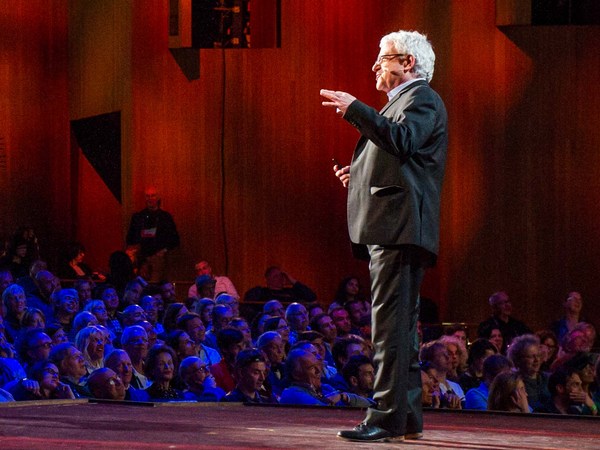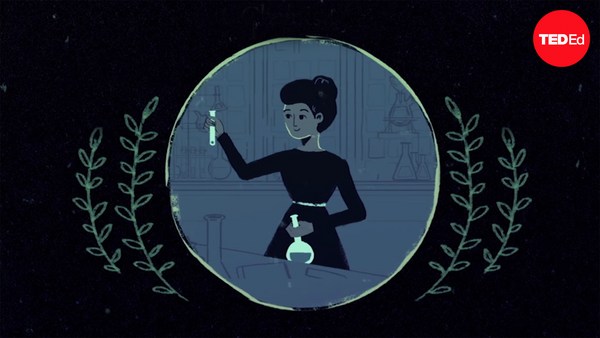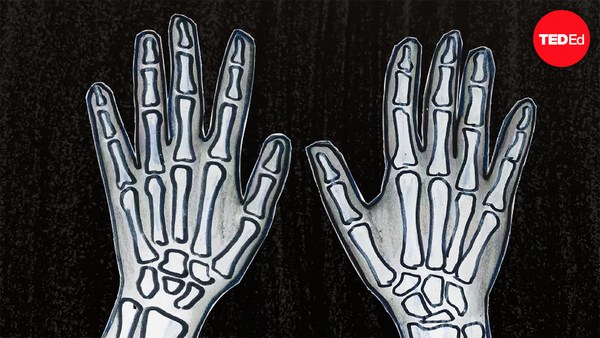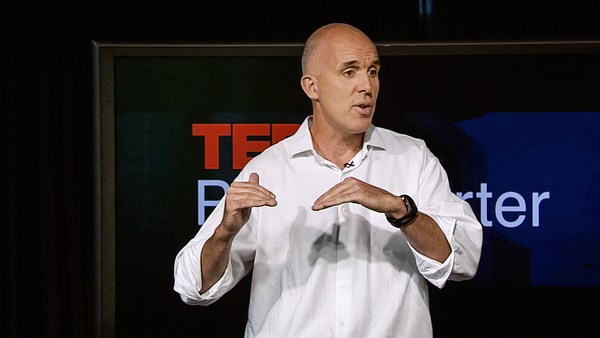George and Charlotte Blonsky, who were a married couple living in the Bronx in New York City, invented something. They got a patent in 1965 for what they call, "a device to assist women in giving birth." This device consists of a large, round table and some machinery. When the woman is ready to deliver her child, she lies on her back, she is strapped down to the table, and the table is rotated at high speed. The child comes flying out through centrifugal force. If you look at their patent carefully, especially if you have any engineering background or talent, you may decide that you see one or two points where the design is not perfectly adequate. (Laughter)
Doctor Ivan Schwab in California is one of the people, one of the main people, who helped answer the question, "Why don't woodpeckers get headaches?" And it turns out the answer to that is because their brains are packaged inside their skulls in a way different from the way our brains, we being human beings, true, have our brains packaged. They, the woodpeckers, typically will peck, they will bang their head on a piece of wood thousands of times every day. Every day! And as far as anyone knows, that doesn't bother them in the slightest.
How does this happen? Their brain does not slosh around like ours does. Their brain is packed in very tightly, at least for blows coming right from the front. Not too many people paid attention to this research until the last few years when, in this country especially, people are becoming curious about what happens to the brains of football players who bang their heads repeatedly. And the woodpecker maybe relates to that.
There was a paper published in the medical journal The Lancet in England a few years ago called " A man who pricked his finger and smelled putrid for 5 years." Dr. Caroline Mills and her team received this patient and didn't really know what to do about it. The man had cut his finger, he worked processing chickens, and then he started to smell really, really bad. So bad that when he got in a room with the doctors and the nurses, they couldn't stand being in the room with him. It was intolerable. They tried every drug, every other treatment they could think of. After a year, he still smelled putrid. After two years, still smelled putrid. Three years, four years, still smelled putrid. After five years, it went away on its own. It's a mystery.
In New Zealand, Dr. Lianne Parkin and her team tested an old tradition in her city. They live in a city that has huge hills, San Francisco-grade hills. And in the winter there, it gets very cold and very icy. There are lots of injuries. The tradition that they tested, they tested by asking people who were on their way to work in the morning, to stop and try something out. Try one of two conditions. The tradition is that in the winter, in that city, you wear your socks on the outside of your boots. And what they discovered by experiment, and it was quite graphic when they saw it, was that it's true. That if you wear your socks on the outside rather than the inside, you're much more likely to survive and not slip and fall.
Now, I hope you will agree with me that these things I've just described to you, each of them, deserves some kind of prize. (Laughter) And that's what they got, each of them got an Ig Nobel prize. In 1991, I, together with bunch of other people, started the Ig Nobel prize ceremony. Every year we give out 10 prizes. The prizes are based on just one criteria. It's very simple. It's that you've done something that makes people laugh and then think. What you've done makes people laugh and then think. Whatever it is, there's something about it that when people encounter it at first, their only possible reaction is to laugh. And then a week later, it's still rattling around in their heads and all they want to do is tell their friends about it. That's the quality we look for.
Every year, we get in the neighborhood of 9,000 new nominations for the Ig Nobel prize. Of those, consistently between 10 percent and 20 percent of those nominations are people who nominate themselves. Those self-nominees almost never win. It's very difficult, numerically, to win a prize if you want to. Even if you don't want to, it's very difficult numerically. You should know that when we choose somebody to win an Ig Nobel prize, We get in touch with that person, very quietly. We offer them the chance to decline this great honor if they want to. Happily for us, almost everyone who's offered a prize decides to accept.
What do you get if you win an Ig Nobel prize? Well, you get several things. You get an Ig Nobel prize. The design is different every year. These are always handmade from extremely cheap materials. You're looking at a picture of the prize we gave last year, 2013. Most prizes in the world also give their winners some cash, some money. We don't have any money, so we can't give them. In fact, the winners have to pay their own way to come to the Ig Nobel ceremony, which most of them do. Last year, though, we did manage to scrape up some money. Last year, each of the 10 Ig Nobel prize winners received from us 10 trillion dollars. A $10 trillion bill from Zimbabwe. (Laughter) You may remember that Zimbabwe had a little adventure for a few years there of inflation. They ended up printing bills that were in denominations as large as 100 trillion dollars. The man responsible, who runs the national bank there, by the way, won an Ig Nobel prize in mathematics.
The other thing you win is an invitation to come to the ceremony, which happens at Harvard University. And when you get there, you come to Harvard's biggest meeting place and classroom. It fits 1,100 people, it's jammed to the gills, and up on the stage, waiting to shake your hand, waiting to hand you your Ig Nobel prize, are a bunch of Nobel prize winners. That's the heart of the ceremony. The winners are kept secret until that moment, even the Nobel laureates who will shake their hand don't know who they are until they're announced.
I am going to tell you about just a very few of the other medical-related prizes we've given. Keep in mind, we've given 230 prizes. There are lots of these people who walk among you. Maybe you have one. A paper was published about 30 years ago called "Injuries due to Falling Coconuts." It was written by Dr. Peter Barss, who is Canadian. Dr. Barss came to the ceremony and explained that as a young doctor, he wanted to see the world. So he went to Papua New Guinea. When he got there, he went to work in a hospital, and he was curious what kinds of things happen to people that bring them to the hospital. He looked through the records, and he discovered that a surprisingly large number of people in that hospital were there because of injuries due to falling coconuts. One typical thing that happens is people will come from the highlands, where there are not many coconut trees, down to visit their relatives on the coast, where there are lots. And they'll think that a coconut tree is a fine place to stand and maybe lie down. A coconut tree that is 90 feet tall, and has coconuts that weigh two pounds that can drop off at any time.
A team of doctors in Europe published a series of papers about colonoscopies. You're all familiar with colonoscopies, one way or another. Or in some cases, one way and another. They, in these papers, explained to their fellow doctors who perform colonoscopies, how to minimize the chance that when you perform a colonoscopy, your patient will explode. (Laughter) Dr. Emmanuel Ben-Soussan one of the authors, flew in from Paris to the ceremony, where he explained the history of this, that in the 1950s, when colonoscopies were becoming a common technique for the first time, people were figuring out how to do it well. And there were some difficulties at first. The basic problem, I'm sure you're familiar with, that you're looking inside a long, narrow, dark place. And so, you want to have a larger space. You add some gas to inflate it so you have room to look around. Now, that's added to the gas, the methane gas, that's already inside. The gas that they used at first, in many cases, was oxygen. So they added oxygen to methane gas. And then they wanted to be able to see, they needed light, so they'd put in a light source, which in the 1950s was very hot. So you had methane gas, which is flammable, oxygen and heat. They stopped using oxygen pretty quickly. (Laughter) Now it's rare that patients will explode, but it does still happen.
The final thing that I want to tell you about is a prize we gave to Dr. Elena Bodnar. Dr. Elena Bodnar invented a brassiere that in an emergency can be quickly separated into a pair of protective face masks. One to save your life, one to save the life of some lucky bystander. (Laughter) Why would someone do this, you might wonder. Dr. Bodnar came to the ceremony and she explained that she grew up in Ukraine. She was one of the doctors who treated victims of the Chernobyl power plant meltdown. And they later discovered that a lot of the worst medical problems came from the particles people breathed in. So she was always thinking after that about could there be some simple mask that was available everywhere when the unexpected happens. Years later, she moved to America. She had a baby, One day she looked, and on the floor, her infant son had picked up her bra, and had her bra on his face. And that's where the idea came from. She came to the Ig Nobel ceremony with the first prototype of the bra and she demonstrated: (Laughter) (Applause) ["Paul Krugman, Nobel laureate (2008) in economics"] ["Wolfgang Ketterle, Nobel laureate (2001) in physics"]
I myself own an emergency bra. (Laughter) It's my favorite bra, but I would be happy to share it with any of you, should the need arise. Thank you. (Applause)





